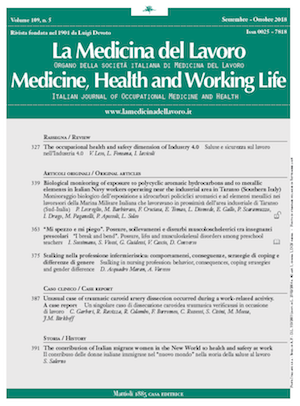The occupational health and safety dimension of Industry 4.0 Industry 4.0 and occupational health
Main Article Content
Keywords
Industry 4.0; Smart factories; Workforce; Health and safety; Risk assessment; Risk management.
Abstract
Background: In recent years, an increase in the worldwide demand for consumer goods and the need for a sustainable type of manufacturing have led to the so-called “fourth industrial revolution” or Industry 4.0. This 4.0 technological revolution, designed to make industrial production more efficient, more flexible and of higher quality, is characterized by greater automation and computerization. This trend will inevitably affect the way work is organized and carried out, and may affect the health and safety of workers. Objectives: To provide a comprehensive overview of the opportunities and problematical aspects of Industry 4.0 in relation to the health and safety of workers. Methods: We conducted a critical review of the literature currently available on this topic. Results: Automated machines and robots can either replace workers or sustain them by making their tasks more flexible, safer, and socially more inclusive. On the other hand, workers will be engaged in tasks requiring decision-making, responsibility and management, as well as man-machine interaction that will expose them both to health and safety risks intrinsically related to automated tools and to greater psychosocial stress. Discussion: Occupational health professionals, responsible for safeguarding health in the workplace, should make an adequate assessment of the risks attributable to 4.0 tools and should promote and protect the health and safety of workers through careful risk management based on continuous occupational training and information.






